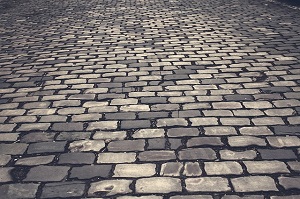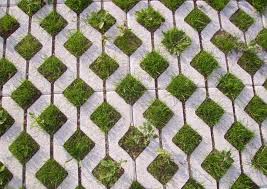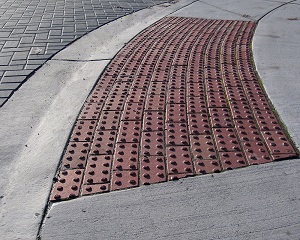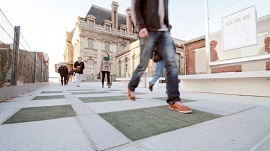Pavement
Contents |
[edit] Introduction
Pavements are a form of exterior surface covering, typically raised and used by pedestrians, running parallel to, and on either side of a road. They provide an area that is separated from, and so protected from vehicular traffic. However, the term can also be used to refer to other paved areas, such as pedestrianised streets, patios, courtyards, driveways, and so on.
Pavements can be constructed using asphalt, concrete, flagstone, cobblestone, artificial stone, bricks, tiles and timber.
The term ‘paver’ or ‘paviour’ (pavior in the USA) refers to a paving stone, tile, brick or piece of concrete used to form a pavement surface. They are usually laid to a fall of 1:60 or more to drain water to one or both sides. They are usually built to a minimum width of 1.2 m where this is possible.
The main British and European Manufacturing Standards relating to paving are:
[edit] Types of pavement
[edit] Flexible paving
This may consist of the following layers:
- 100 mm blinded and consolidated hardcore.
- 40 mm thick base course of coated macadam.
- 20 mm thick wearing course of coated macadam.
[edit] Rigid paving
This may consist of the following layers:
- 75 mm thick consolidated hardcore.
- 75 mm thick plain insitu concrete with contraction and expansion joints.
[edit] Pavers
This may consist of the following layers:
- 75 mm thick consolidated hardcore.
- 25 mm thick dry cement/sand bed.
- 600 x 600 x 50 mm precast concrete pavers laid with butt joints filled with mortar.
[edit] Small unit pavers
This may consist of the following layers:
- 100 mm thick consolidated hardcore.
- 50 mm thick bed of sharp sand.
- 60 mm thick precast concrete plain or interlocking pavers vibrated into bed with sand-filled joints.
[edit] Cobblestones
Cobblestone were frequently used in early pavement construction. They are small stones or pebbles that were traditionally gathered from stream beds and hence had been rounded and smoothed by water. They are usually set in sand or bound together with mortar.
[edit] Setts
Setts are rectangular stones, usually made of granite, often used in landscape architecture as they can be arranged in various decorative ways with different patterns and colours.
The second edition of The Dictionary of Urbanism by Rob Cowan, published in 2020, suggests that a sett is: ‘A small rectangular quarried stone used for paving. Setts are often popularily called cobbles (see cobbled). Wooden and rubber setts have also occasionally been used.'
A Belgian block is: ‘A cubical paving block; a sett’
[edit] Interlocking grids
These are concrete or stone units with open, permeable spaces between them.
[edit] Tactile paving
These come in a variety of forms and are commonly used in urban areas as a means of hazard warning for visually-impaired pedestrians at kerb edges, road crossings and gradient changes. They can also be used on cycle paths as a way of demarcating the area to be used by cyclists.
For more information, see Hazard warning surfaces.
[edit] Green paving
New products are being developed that incorporate technology with to make pavements smarter and greener. For example, see Pavegen.
[edit] Other definitions
The second edition of The Dictionary of Urbanism by Rob Cowan, published in 2020, suggests that pavement can mean:
- '(UK) The raised surface for pedestrians beside a street or road. The US equivalent is sidewalk, though pavement is used in some parts of the southern states.
- (US, and UK highway engineers) The structure of a road, including its surface and underlying foundations. The general UK equivalent is roadway.
- A paved surface.
- An alley.
From the Latin pavire, to beat hard.'
[edit] Related articles on Designing Buildings
- Binder course.
- Bitumen binder may delay road surface deterioration.
- Bituminous mixing and laying plant.
- BREEAM Hard landscaping and boundary protection.
- Britain's historic paving.
- Capping layer.
- Coal holes, pavement lights, kerbs and utilities and wood-block paving.
- Code of Practice for Ironwork Systems Installation and Refurbishment.
- Glossary of paving terms.
- Groundwater control in urban areas.
- Hazard warning surfaces.
- Highway drainage.
- Hoggin.
- How to lay block paving.
- Kerbs.
- Landscape design.
- Overview of the road development process.
- Pavegen.
- Pedestrianised.
- Permeable pavements.
- Pervious pavement.
- Road construction.
- Types of road and street.
- Vicars' close.
- Walkway.
[edit] External references
- ‘Building Construction Handbook’ (6th ed.), CHUDLEY, R., GREENO, R., Butterworth-Heinemann (2007)
Featured articles and news
Art of Building CIOB photographic competition public vote
The last week to vote for a winner until 10 January 2025.
The future of the Grenfell Tower site
Principles, promises, recommendations and a decision expected in February 2025.
20 years of the Chartered Environmentalist
If not now, when?
Journeys in Industrious England
Thomas Baskerville’s expeditions in the 1600s.
Top 25 Building Safety Wiki articles of 2024
Take a look what most people have been reading about.
Life and death at Highgate Cemetery
Balancing burials and tourism.
The 25 most read articles on DB for 2024
Design portion to procurement route and all between.
The act of preservation may sometimes be futile.
Twas the site before Christmas...
A rhyme for the industry and a thankyou to our supporters.
Plumbing and heating systems in schools
New apprentice pay rates coming into effect in the new year
Addressing the impact of recent national minimum wage changes.
EBSSA support for the new industry competence structure
The Engineering and Building Services Skills Authority, in working group 2.
Notes from BSRIA Sustainable Futures briefing
From carbon down to the all important customer: Redefining Retrofit for Net Zero Living.
Principal Designer: A New Opportunity for Architects
ACA launches a Principal Designer Register for architects.


























